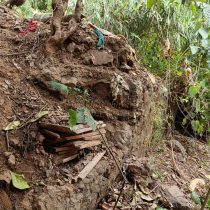JOONANDURKHI
TYPE : FORTRESS
DISTRICT : PALGHAR
GRADE : EASY
Bhiwandi was a major port in medieval times and was directly connected to the sea. The Kamwari River, a tributary of the Ulhas River, used to have direct connection to Bhiwandi. To protect this sea route, the Portuguese built many small forts like Kharbav, Firangkot, Nandurkhi, Junandurkhi, Kambe kot, Karivali. Junandurkhi fort is one such small fort built by the Portuguese at Junandurkhi village between Bhiwandi-Vasai. Today this fort is completely surrounded by the growing population of the village and this fort has very less remains. This is a small attempt to introduce this fort to people. To reach Junandurkhi Fort one can go to Junandurkhi Fort by visiting Kharbav and Firang Fort on Vasai-Chinchoti-Anjurphata-Bhiwandi road and from there to Kambe Fort or via Bhiwandi via Bhiwandi-Parola road. Junandurkhi distance is 10 km from Bhiwandi and one can reach Junandurkhi village by private rickshaw.
...
The distance from Kambe village is about 2 km. If you come by bus, Junandurkhi village is about 2 km from the main road. Locals do not know much about this fort but if you inquire as “madi” while asking, they bring you to this place and drop you off. Or take the help of now this location is shown on google map. The entire Fort is now surrounded by houses in the village. As the Fort has completely collapsed and only few remains left, it cannot be said with certainty whether this place was tax collection office or Fort. Considering the location and size of this fort, this fort must have been used as watch station during the Portuguese period. The size of the Fort square is 30x30 feet and stone and lime are used in this construction. 10 minutes is enough to see the fort. The Kamwari River flows near the village. The Portuguese are a riverine tribe. They built most of the Fort on the coast so that they could have a direct connection with Portugal by sea way. Located between Vasai and Bhiwandi, these forts on Ulhas Creek are built on both sides of Kamwari Creek. Built by the Portuguese around the 16th century, the main purpose of these forts was to protect waterways and provide necessary logistics to small and large forts in the province. Using all these small forts, watchtowers and long-range cannons, the Portuguese established their empire along the North Konkan sea route. Those who come with expectation to see a fort are likely to be disappointed, but those who want to see the Portuguese watch post on the ancient sea trade route and its geographical importance must visit this place. It is recorded that the Marathas under the leadership of Pilaji Jadhav conquered Kambe Fort in 1730 AD. As it was nearby at that time, this fort might also have come under the control of the Marathas. Later, in the Maratha-Portuguese treaty, this fort again came under the control of the Portuguese. In this Vasai campaign of 1739 AD, the area of Kharbav, Kambe, and Firangipada came under the control of the Marathas and the Portuguese left this area forever. These forts, which have played a significant role in history, should be preserved today, otherwise the coming generation will have nothing to see.
© Suresh Nimbalkar







